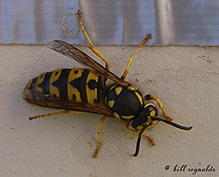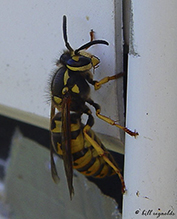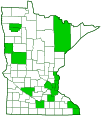German yellowjacket
(Vespula germanica)
Conservation • Description • Habitat • Ecology • Distribution • Taxonomy
Conservation Status |
|||
| IUCN Red List | not listed |
||
| NatureServe | NNR - Unranked |
||
| Minnesota | not listed |
||
Description
German yellowjacket is a medium-sized, predatory, social, non-native wasp. It is native to Europe, Asia, and North Africa. It was unintentionally introduced into Canada in the 1960s and the eastern United States in the 1970s. It quickly spread and by 1989 it had reached California.
Adults are ½″ to ⅝″ long. The stout body is slightly wider than the head.
There are two large compound eyes, one on each side of the head; and three small simple eyes (ocelli) at the top of the head between the compound eyes. The yellow band behind the compound eye is continuous to the jaw (mandible), not narrowed or interrupted. The upper (dorsal) space between the compound eyes is entirely black—there is no yellow “eye loop”. The gap between the mandible and the compound eye is narrow, no more than the diameter of one ocellus. The distance between the rear ocellus and the hind margin of the upper surface of the head (vertex) is no more than the diameter of one ocellus. The face has three small black spots.
The antennae are long and black.
The dorsal surface of the largest section of the thorax (scutum) is black with no stripes down the middle. A yellow band at the leading edge of the pronotum is interrupted at the apex (nearest to the head).
The abdomen of the female has six segments, while that of the male has seven segments. The upper plate (tergum) of each abdominal segment is yellow with black markings. The first tergum has a diamond-shaped basal mark that is less than twice as wide as long. At least one of the remaining terga has a pair of black spots completely surrounded by yellow, not connected to the basal black mark.
The legs are yellow.
The wings are clear.
Size
Females: ½″ to ⅝″
Similar Species
Habitat
Ecology
Season
May to the first hard frost
Behavior
Worker wasps are short lived. Throughout their life they will perform 3 or 4 tasks, one at a time, at different stages of their life.
Life Cycle
In the spring a queen emerges from hibernation and mates with up to 7 males. In early summer she builds an embryonic nest. The papery nest is constructed from chewed wood fibers cemented with saliva. It is usually built underground but may also be built in an stump, attic, roof, hollow wall, or other sheltered part of a human structure. It begins as just three hexagonal cells, and into each cell she deposits a single egg. She continues building cells while caring for the grubs as they hatch. Through spring and summer the queen produces a large number of worker wasps. In late summer she begins producing queens and males. In Minnesota the nests do not survive the winter. Old queens, males, and workers are killed by cold weather in the fall, while new queens hibernate.
Larva Food/Hosts
Pre-chewed fragments of caterpillars and other soft-bodied insects.
Adult Food
Live arthropods; carrion; fruit; honeydew of aphids, caterpillars, and some scale insects; human processed food and garbage; and other sources of protein and sugar. Queens feed on flower nectar in the spring.
Distribution |
||
|
Sources |
|
| 10/3/2025 | ||
Occurrence |
||
Common |
||
Taxonomy
Order
Hymenoptera (Ants, Bees, Wasps, and Sawflies)
Suborder
Apocrita (Narrow-waisted Wasps, Ants, and Bees)
Infraorder
Aculeata (Ants, Bees, and Stinging Wasps)
Superfamily
Vespoidea (vespoid wasps)
Family
Vespidae (hornets, paper wasps, potter wasps, and allies)
Subfamily
Vespinae (hornets and yellowjackets)
Genus
Vespula (ground yellowjackets)
Subordinate Taxa
Synonyms
Vespa germanica
Vespa macularis
Common Names
German yellow-jacket
German yellowjacket
Glossary
Ocellus
Simple eye; an eye with a single lens. Plural: ocelli.
Pronotum
The exoskeletal plate on the upper side of the first segment of the thorax of an insect.
Scutum
The forward (anterior) portion of the middle segment of the thorax (mesonotum) in insects and some arachnids.
Tergum
The upper (dorsal) surface of a body segment of an arthropod. Plural: terga.
Vertex
The upper surface of an insect’s head.
Visitor Photos
Share your photo of this insect.
This button not working for you?
Simply email us at info@MinnesotaSeasons.com.
Attach one or more photos and, if you like, a caption.
Bill Reynolds |
||
 |
 |
|
MinnesotaSeasons.com Photos
|

Slideshows

Visitor Videos
Share your video of this insect.
This button not working for you?
Simply email us at info@MinnesotaSeasons.com.
Attach a video, a YouTube link, or a cloud storage link.
Other Videos
German Yellowjacket (Vespidae: Vespula germanica) Grooming
Carl Barrentine
German Yellowjacket (Vespulidae: Vespula germanica) Queen in Torpor Position
Carl Barrentine
German Wasp (Vespula germanica) collecting wood for nest
Stephen Plummer
(Dolichovespula) Vespula germanica
Messorus
My Yellowjacket Small Familys In My Garden pt 1
Sarai Alvarez

Visitor Sightings
Report a sighting of this insect.
This button not working for you?
Simply email us at info@MinnesotaSeasons.com.
Be sure to include a location.
Minnesota Seasons Sightings


